Welcome to the ultimate guide for creating the most flavorful and satisfying Greek Salmon at home. This incredible recipe brings the vibrant, fresh tastes of the Mediterranean directly to your kitchen. Imagine succulent salmon fillets, perfectly pan-seared to a golden crisp, infused with classic Greek elements like robust olive oil, zesty lemon, aromatic garlic, and earthy oregano. Crowned with a refreshing homemade Greek salsa brimming with juicy tomatoes, crisp cucumber, sharp red onion, briny Kalamata olives, and creamy feta, this dish is not just a meal; it’s an experience. It’s both hearty and delightfully light, incredibly easy to prepare in a single pan, making it the ideal solution for a busy weeknight dinner or an elegant weekend feast.

If you’re seeking a fast, delicious, and healthy dinner solution, look no further. This easy Greek salmon recipe relies on readily available pantry staples and fresh kitchen ingredients for its accompanying salsa. It consistently earns rave reviews and presents beautifully, making it perfect for impressing guests without the fuss. Serve it alongside a simple green salad, fluffy rice, or any of the delightful side dishes available in the extensive collection on my blog for a complete and balanced meal.
For those who adore the versatility and flavor of salmon, I invite you to explore more of my popular recipes. Discover the sweet and savory delight of my Honey Garlic Salmon Bites, the bright simplicity of Easy Lemon Pepper Salmon, the refreshing crunch of Greek Style Grilled Salmon Salad, or the exciting kick of Spicy Honey Garlic Salmon. Each recipe offers a unique take on this beloved fish, ensuring there’s a salmon dish for every craving.
Why This Greek Salmon Recipe Will Become Your New Favorite
This Greek Salmon dish isn’t just another fish recipe; it’s a culinary gem that offers a multitude of reasons to love it. From its lightning-fast preparation to its incredible health benefits, here’s why it deserves a permanent spot in your recipe rotation:
- Effortlessly Easy & Incredibly Quick: Say goodbye to complicated recipes and hours in the kitchen. This pan-seared Greek salmon comes together in approximately 15 minutes from start to finish. With minimal ingredients and straightforward steps, it’s the ultimate speedy meal solution for those hectic weeknights when time is of the essence. The fresh salsa, too, can be whipped up in mere minutes, perfectly complementing the fast-cooking fish.
- Bursting with Authentic Mediterranean Flavor: Prepare your taste buds for an explosion of authentic Greek flavors. The harmonious blend of zesty lemon, pungent garlic, and earthy dried oregano and basil permeates every flake of the salmon, creating a truly vibrant and fresh taste profile. This traditional seasoning, coupled with the rich olive oil, delivers a wonderfully aromatic and satisfying experience that will transport you straight to the shores of Greece.
- Nutritious Powerhouse for a Healthy Lifestyle: Salmon is renowned for being an excellent source of Omega-3 fatty acids, vital for heart health and brain function. Combined with the fresh, vitamin-rich vegetables in the Greek salsa and the healthy fats from olive oil, this recipe is a cornerstone of the Mediterranean diet. It’s a meal that not only tastes incredible but also genuinely nourishes your body, contributing to a balanced and wholesome diet.
- Remarkably Versatile and Adaptable: One of the best aspects of this Greek salmon is its incredible versatility. It pairs beautifully with an array of side dishes, allowing you to customize your meal based on your preferences or what you have on hand. Whether you prefer roasted vegetables, a fresh salad, or a grain-based accompaniment, this salmon effortlessly complements any side, making it suitable for any occasion, from casual family dinners to more formal gatherings.
- Elegant Presentation, Simple Execution: Despite its quick preparation, this Greek salmon looks sophisticated and impressive on the plate. The vibrant colors of the salsa contrasting with the golden-brown salmon make for a visually appealing dish that’s sure to impress your family and guests. It’s a fancy-looking meal that doesn’t require gourmet skills to achieve.
Essential Greek Salmon Ingredients
Crafting this exquisite Greek Salmon dish requires a selection of fresh, high-quality ingredients that are easy to find. Here’s a closer look at what you’ll need to bring these Mediterranean flavors to life:

- Salmon Fillets: The star of our dish! Aim for fresh, high-quality salmon fillets, ideally around 6-8 ounces each. For even cooking, try to select fillets that are uniform in thickness and size. You can choose skin-on or skinless; skin-on often results in a crispier texture. Wild-caught salmon like Sockeye or Coho often offer a richer flavor and color, while Atlantic salmon (often farmed) is widely available and also works wonderfully.
- Extra Virgin Olive Oil: A cornerstone of Greek cuisine, olive oil is essential for both seasoning the salmon and searing it to perfection. Choose a good quality extra virgin olive oil for its rich flavor and health benefits. If you prefer a milder taste or have a different oil preference, avocado oil or grapeseed oil are excellent alternatives due to their high smoke points.
- Greek Seasoning Blend: This aromatic blend elevates the salmon’s flavor profile. My go-to combination includes:
- Dried Oregano: Provides that quintessential Mediterranean herb flavor.
- Dried Basil: Adds a sweet, peppery note that complements the oregano.
- Garlic Powder: Delivers a deep, savory garlic flavor without the risk of burning fresh garlic.
- Onion Powder: Enhances the overall savory depth, marrying well with the garlic.
- Salt & Freshly Ground Black Pepper: Essential for seasoning and bringing out all the flavors.
- Fresh Greek Salsa Ingredients: The vibrant, refreshing salsa is what truly makes this dish shine. You’ll need:
- Grape Tomatoes: Halved for a burst of sweet juiciness. Cherry tomatoes also work beautifully.
- Cucumber: Diced or thinly sliced for a cool, crisp contrast. English cucumbers are ideal as they have fewer seeds.
- Red Onion: Finely diced to add a sharp, piquant kick. Soaking it in cold water for 10 minutes can mellow its intensity if preferred.
- Kalamata Olives: Sliced or chopped for their distinctive briny, fruity, and slightly smoky flavor, a hallmark of Greek cuisine.
- Feta Cheese: Crumbled feta adds a creamy, salty tang that is simply irresistible. Opt for authentic Greek feta if possible.
- Fresh Lemon Juice: Provides a bright, acidic counterpoint that ties all the salsa ingredients together.
- Fresh Dill Leaves: Chopped fresh dill introduces a unique herbaceous, slightly anise-like freshness that is classic in Greek salads and dishes. If fresh dill isn’t available, a tiny pinch of dried dill can be used, but fresh is highly recommended.
Ingredient Substitutions and Creative Variations
Don’t have all the ingredients on hand, or simply want to experiment? This recipe is incredibly flexible!
Salmon Alternatives: While salmon is ideal, you can easily substitute with other firm, flaky white fish. Consider using trout for a similar richness, cod for a milder flavor, or halibut for a substantial, meaty texture. Adjust cooking times slightly based on the thickness of your chosen fish.
Oil Swaps: Extra virgin olive oil offers the most authentic Greek flavor, but if you’re looking for alternatives, avocado oil or grapeseed oil are excellent choices for pan-searing due to their higher smoke points and neutral flavors. Coconut oil can also be used for a slight tropical hint.
Herb & Seasoning Enhancements: Feel free to experiment with other Mediterranean herbs. Fresh oregano or basil, finely chopped, can be used instead of dried for an even brighter flavor. A touch of dried thyme or rosemary can also be added to the salmon seasoning. For a spicy kick, a pinch of red pepper flakes can be included in the seasoning mix.
Salsa Customizations: The Greek salsa is wonderfully adaptable.
- Vegetables: Add finely diced bell peppers (red, yellow, or orange) for extra crunch and sweetness, or thinly sliced radicchio for a hint of bitterness. Sun-dried tomatoes (oil-packed and drained) can also offer a concentrated tomato flavor.
- Olives: If Kalamata olives aren’t your favorite, green olives or a mix of various Mediterranean olives can be used.
- Cheese: For a dairy-free option, omit the feta or use a plant-based feta alternative. Goat cheese crumbles could also offer a different creamy tang.
- Acid: A splash of red wine vinegar can deepen the tanginess of the salsa if you prefer.
Citrus Zest: For an extra burst of fresh lemon flavor, add a teaspoon of lemon zest to both the salmon seasoning and the salsa. This will brighten the entire dish without adding extra liquid.
Garlic Boost: If you love garlic, feel free to add 1-2 cloves of minced fresh garlic to the salmon fillets before searing, or to the salsa for a more pungent flavor.
How To Make Pan-Seared Greek Salmon: A Step-by-Step Guide
Creating this delicious Greek Salmon is simpler than you might think. Follow these straightforward steps to achieve a perfectly cooked, flavor-packed meal:
Step 1: Prepare the Salmon Fillets
Begin by patting your salmon fillets dry with paper towels. This crucial step helps achieve that desirable crispy skin (if skin-on) and allows the seasonings to adhere better. Place the dried fillets on a clean surface. Drizzle one tablespoon of extra virgin olive oil evenly over both sides of each salmon fillet. Use a pastry brush or your fingers to ensure a light, even coating. This initial oil layer helps in seasoning distribution and prevents sticking.
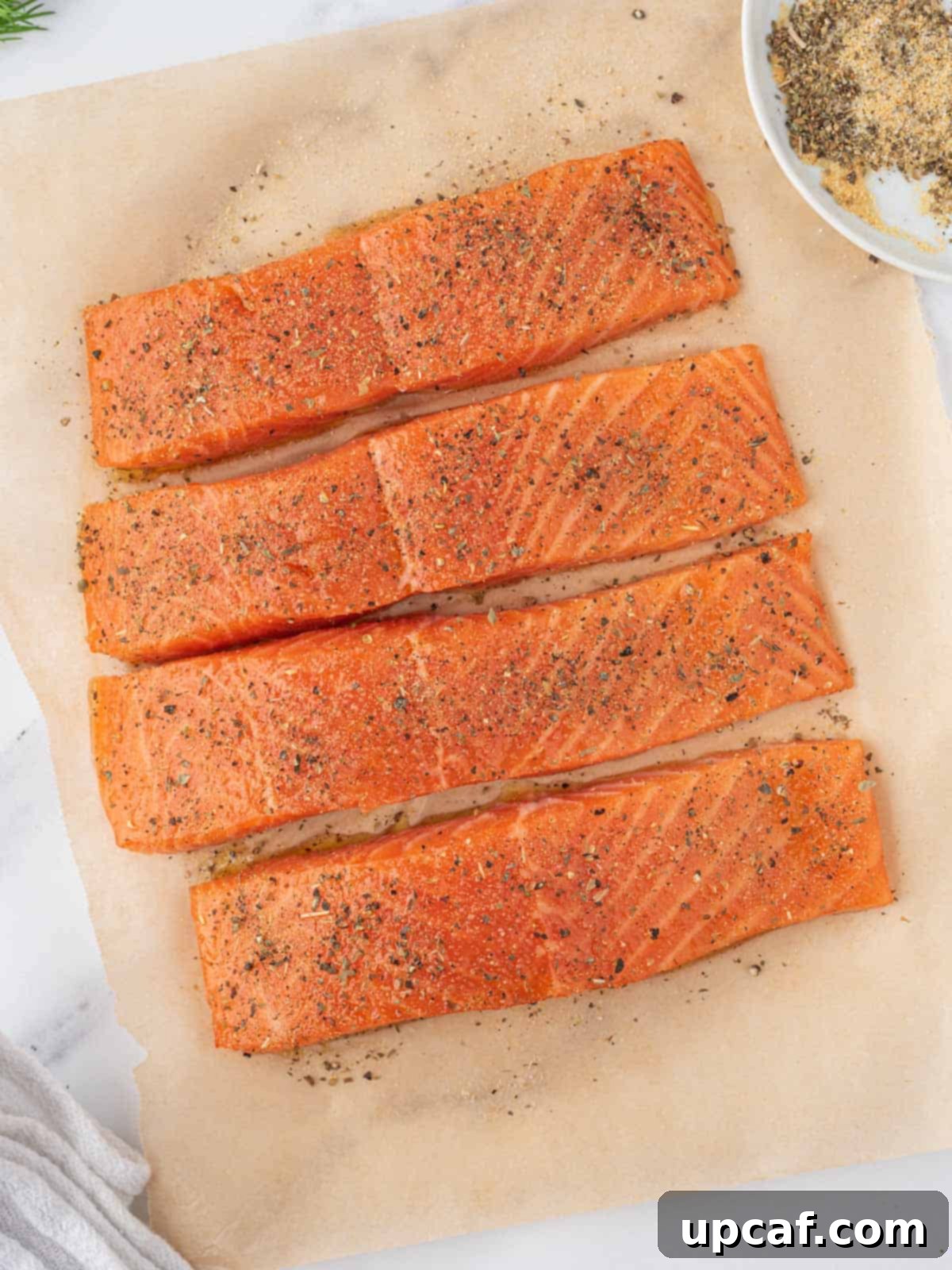
Step 2: Create and Apply the Greek Seasoning Blend
In a small bowl, combine your Greek seasoning blend: ½ teaspoon dried oregano, ½ teaspoon dried basil, ½ teaspoon garlic powder, ½ teaspoon onion powder, ½ teaspoon salt, and ½ teaspoon freshly ground black pepper. Mix these spices thoroughly until well combined. Generously rub this aromatic seasoning mixture over both sides of the olive oil-coated salmon fillets. Ensure the seasoning is evenly distributed to infuse maximum flavor into the fish.
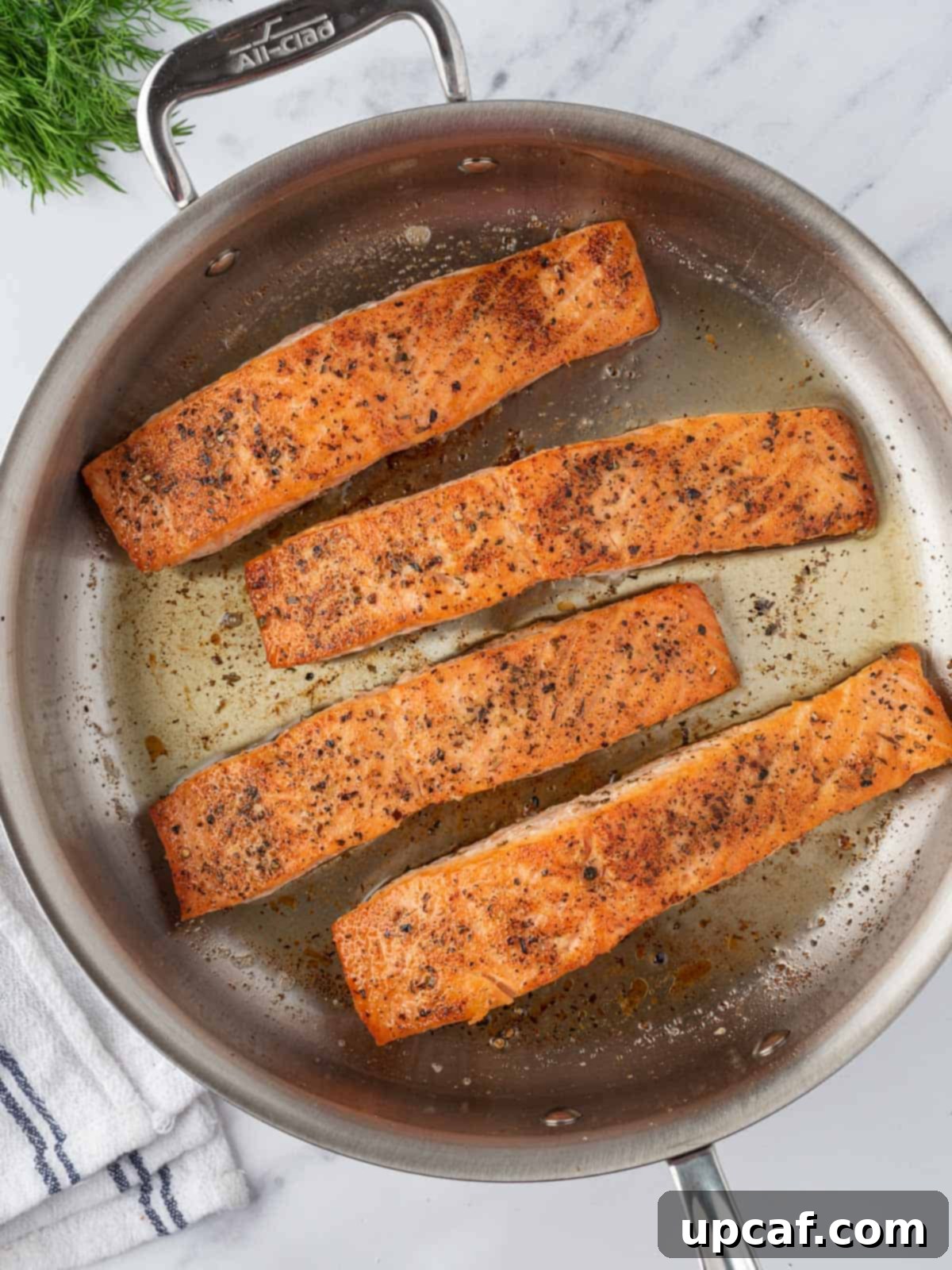
Step 3: Perfectly Pan-Sear the Salmon
Heat a large, heavy-bottomed skillet (cast iron or stainless steel works best) over medium-high heat. Add the remaining tablespoon of olive oil to the hot skillet, ensuring it coats the bottom. Once the oil is shimmering and hot (but not smoking), carefully place the seasoned salmon fillets, skin-side down (if applicable), into the pan. Sear for 4-5 minutes, undisturbed, until the skin is beautifully crispy and golden brown, and the flesh has started to turn opaque about one-third of the way up the fillet. Gently flip the salmon to the other side using a thin spatula. Continue to cook for another 2-3 minutes, or until the salmon is cooked through and flakes easily with a fork. The internal temperature should reach 145°F (63°C) at its thickest part.
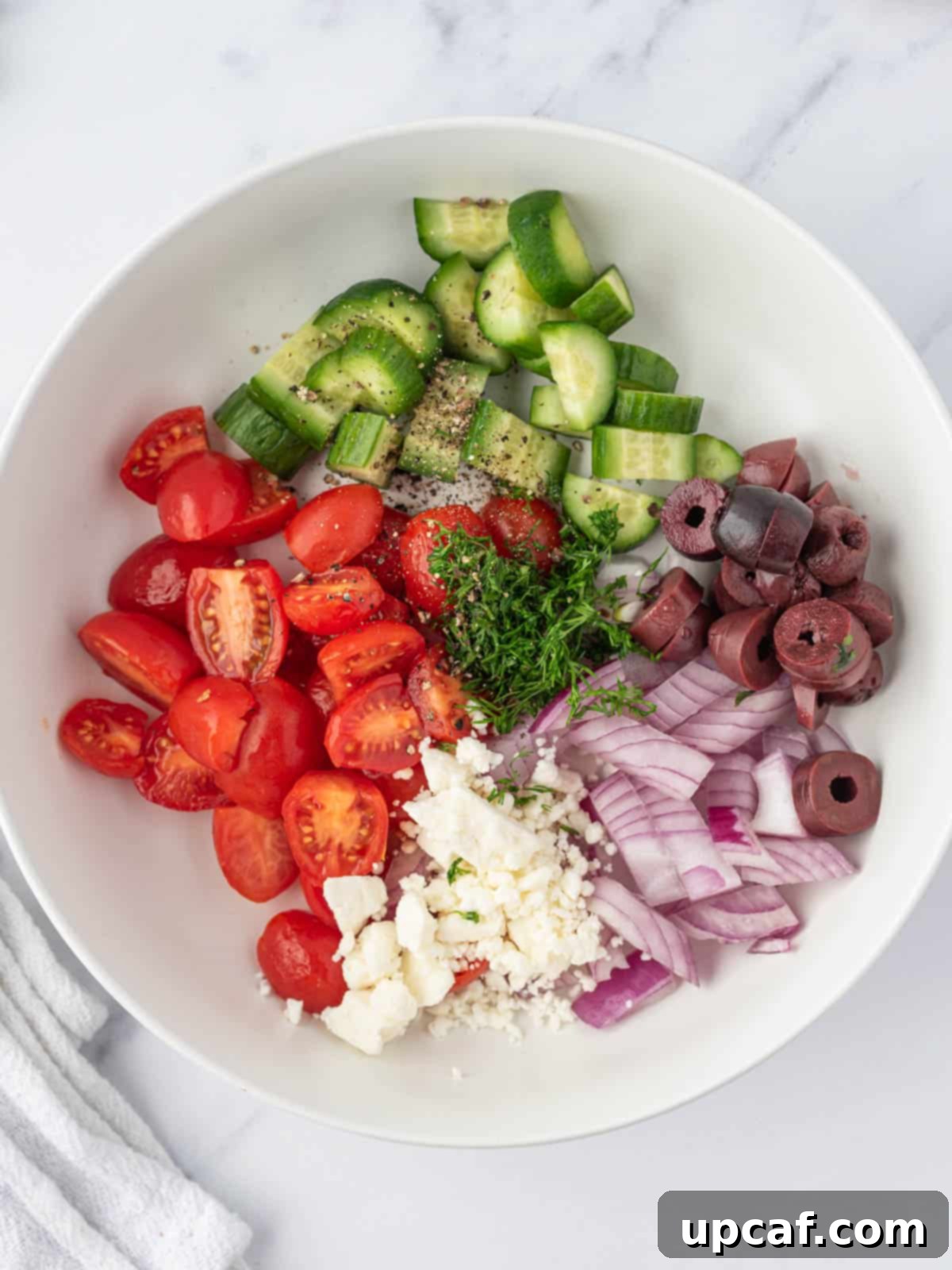
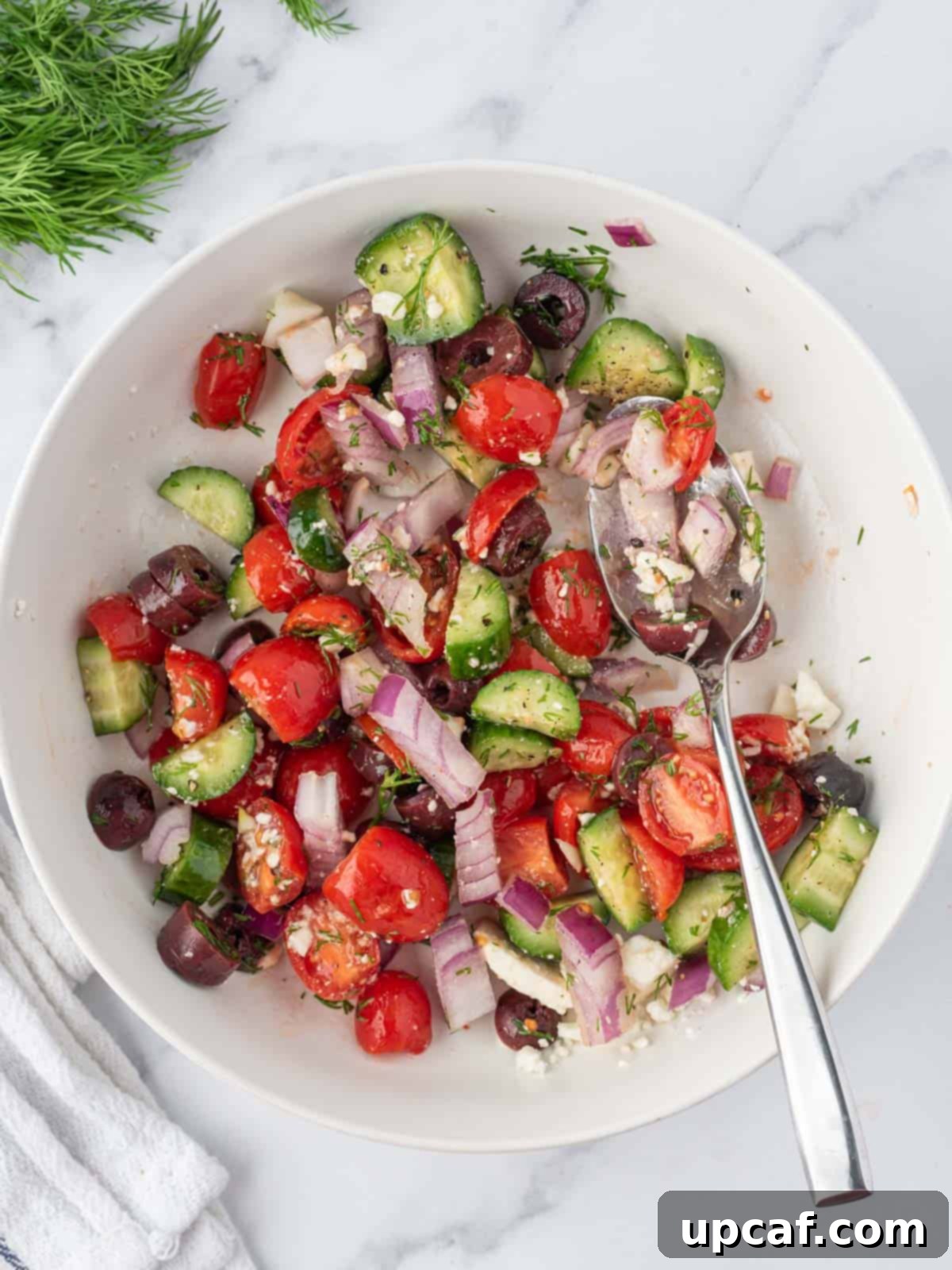
Step 4: Prepare the Refreshing Greek Salsa
While the salmon is searing, quickly assemble the vibrant Greek salsa. In a wide mixing bowl, combine the halved grape tomatoes, sliced cucumber, diced red onion, sliced Kalamata olives, crumbled feta cheese, one tablespoon of olive oil, one tablespoon of fresh lemon juice, and the chopped fresh dill leaves. Season with salt and pepper to taste. Gently toss all the ingredients together until they are well combined. Taste and adjust seasonings if necessary, ensuring a perfect balance of flavors.
Step 5: Serve and Enjoy Immediately
Once the salmon is cooked to perfection, transfer the fillets to individual serving plates. Top each piece of pan-seared Greek salmon generously with a spoonful or two of the freshly made, bright Greek salsa. Serve immediately and savor the incredible fusion of Mediterranean flavors.
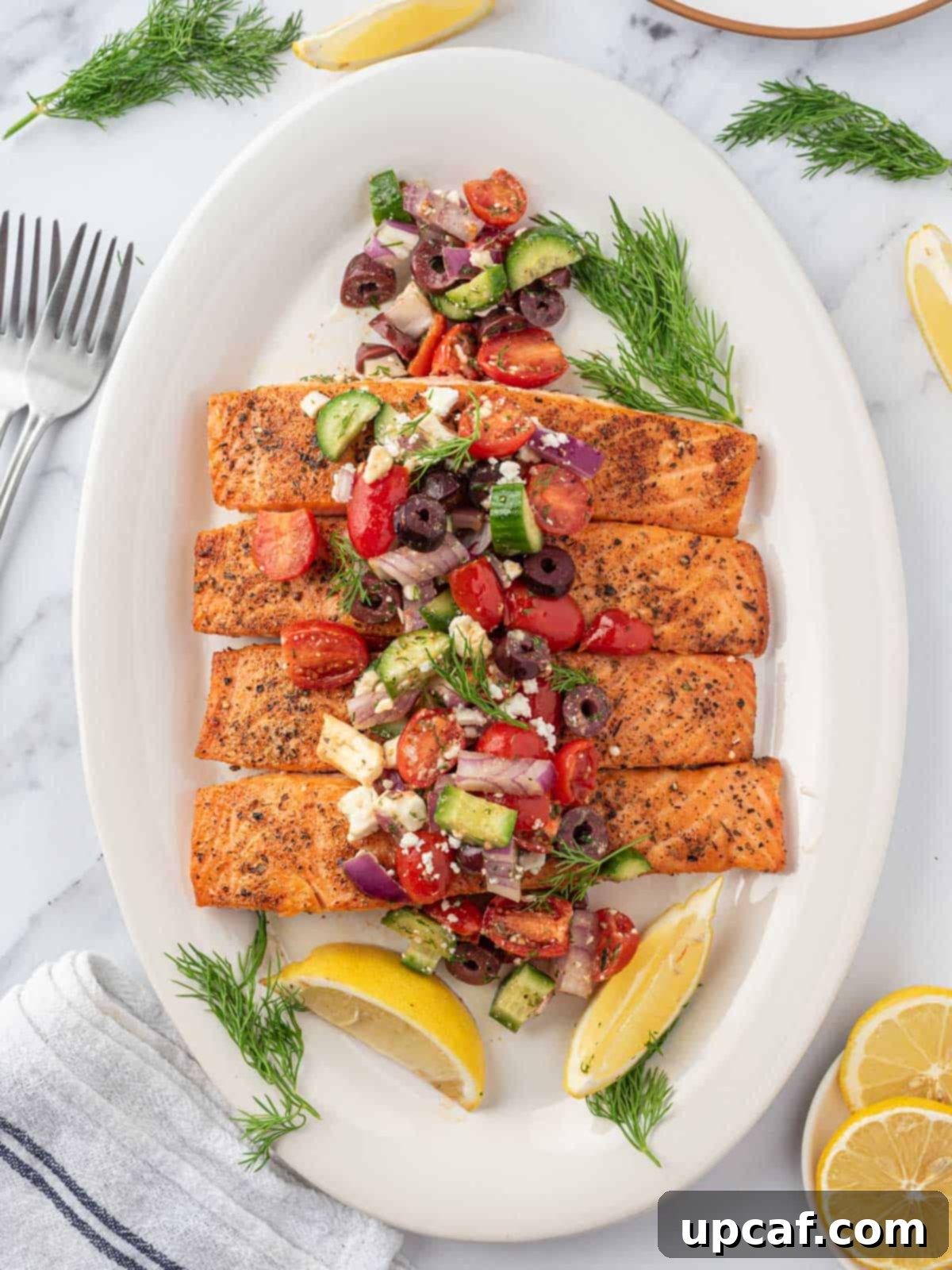
Expert Tips for Making the Best Greek Salmon Recipe
Achieving restaurant-quality Greek salmon at home is simple with a few key techniques. Here are my top tips to ensure your dish is nothing short of spectacular:
- Prioritize Fresh Ingredients: The true essence of this dish comes from its fresh components. Opt for fresh lemon juice, vibrant fresh dill, and ripe vegetables for your salsa. The difference in flavor between fresh and pre-packaged or bottled ingredients is significant and will elevate your salmon from good to exceptional.
- Don’t Overcook the Salmon: This is arguably the most crucial tip for moist and tender salmon. Salmon cooks quickly! Overcooked salmon becomes dry and tough. Aim to cook it just until it flakes easily with a fork and the internal temperature reaches 145°F (63°C) at its thickest part. The center should still be slightly pink.
- Pat the Salmon Dry: Before seasoning, use paper towels to thoroughly pat the salmon fillets dry. This removes excess moisture, which is essential for achieving a beautiful, crispy sear on the outside, especially if you’re cooking skin-on fillets.
- Preheat Your Skillet Properly: A hot skillet is key for a good sear. Allow your pan and olive oil to heat up thoroughly over medium-high heat until the oil is shimmering but not smoking. Placing salmon in a cold or lukewarm pan will result in sticking and a less desirable texture.
- Marinate for Enhanced Flavor: While this recipe is quick, allowing the salmon to marinate in the olive oil, lemon, garlic, and herb mixture for at least 15-30 minutes before cooking can significantly deepen its flavor. For an even more intense taste, you can marinate it in the refrigerator for up to 2 hours.
- Avoid Overcrowding the Pan: Cook the salmon in batches if necessary. Overcrowding the skillet will lower the pan’s temperature, leading to steaming rather than searing. This prevents the salmon from getting that delicious crispy crust. Ensure there’s ample space around each fillet.
- Serve Immediately for Optimal Texture: This Greek salmon dish, particularly with its fresh salsa, is best enjoyed right after cooking. The warm, flaky salmon and the crisp, cool salsa create a perfect textural and temperature contrast that is most delightful when fresh.
What to Serve with Greek Salmon for a Complete Meal
This versatile Greek salmon pairs beautifully with a wide array of side dishes, allowing you to create a complete and satisfying Mediterranean-inspired meal. Here are some delicious suggestions:
Roasted or Steamed Vegetables:
Elevate your meal with simple, wholesome vegetables. Roasted vegetables like zucchini, bell peppers (red, yellow, orange), asparagus, or green beans tossed with olive oil, salt, and pepper make a fantastic complement. Their sweetness and slight char pair wonderfully with the salmon. For an effortless option, try my Easy Mixed Vegetables recipe.
Fresh Salads:
A light and refreshing salad is always a good choice. A classic Greek salad, featuring crisp cucumbers, ripe tomatoes, Kalamata olives, red onion, and crumbled feta cheese, dressed with a simple lemon-oregano vinaigrette, complements the salmon perfectly. For a heartier option, consider my Easy Greek White Bean Salad, which adds protein and fiber.
Potatoes and Grains:
If you’re looking for something more substantial, potatoes or grains are excellent choices. Serve the salmon with lemon roasted potatoes, crispy roasted baby potatoes (like my Crispy Roasted Baby Potatoes recipe), or a creamy potato salad. Alternatively, a fluffy pilaf, simple couscous, or quinoa salad can absorb the salmon’s flavors beautifully and add a wholesome base to your plate.
Warm Pita Bread or Crusty Bread:
Don’t forget the bread! Warm pita bread, cut into wedges, or a piece of crusty artisan bread is perfect for soaking up any delicious juices from the salmon and salsa. It adds a delightful texture and completes the Mediterranean dining experience.
Yogurt-Based Dips:
A cooling and tangy dip can enhance the flavors even further. A homemade tzatziki sauce (cucumber, Greek yogurt, garlic, dill) or a simple lemon-dill yogurt sauce can be drizzled over the salmon or served on the side for dipping.

Storing and Reheating Greek Salmon
Proper storage and reheating ensure you can enjoy leftover Greek salmon without compromising its flavor or texture.
Storing Greek Salmon:
- Refrigeration: Once your cooked salmon has completely cooled to room temperature, transfer it to an airtight container. Store it in the refrigerator for up to 3 days. It’s best to store the salmon and salsa separately if possible, to maintain the salsa’s freshness and prevent the salmon from becoming soggy.
- Freezing: For longer storage, you can freeze cooked salmon. Wrap individual fillets tightly in plastic wrap, then place them in a freezer-safe bag or container, pressing out any excess air. Frozen salmon will maintain its quality for up to 2 months. When you’re ready to enjoy it again, thaw the salmon in the refrigerator overnight before reheating. The salsa, however, is best made fresh and does not freeze well due to its high water content.
Reheating Greek Salmon:
- Oven Method (Recommended): This method is ideal for reheating salmon as it helps retain moisture and prevents drying. Preheat your oven to a low temperature, around 275°F (135°C). Place the salmon fillets on a baking sheet and cover them loosely with aluminum foil. Heat for 10-15 minutes, or until the salmon is warmed through. The foil helps to steam the fish gently and keep it from drying out.
- Microwave Method (Use with Caution): If you’re in a hurry, the microwave can be used, but be aware that it can sometimes dry out salmon. Place the salmon on a microwave-safe plate and cover it with a microwave-safe lid or a damp paper towel. Reheat on medium power in short 30-second intervals, checking frequently, until warmed through. Avoid high power and long cooking times to prevent rubbery salmon.
Remember that reheated salmon, while still delicious, might not have the exact same flaky texture as freshly cooked. The salsa should always be served fresh, so prepare a new batch or store the leftover salsa separately for best results.
Frequently Asked Questions About Greek Salmon
Ideally, wild-caught salmon, such as Sockeye or Coho, is my top choice for its superior flavor, firmer texture, and sustainable sourcing. However, you can also use high-quality frozen center-cut Atlantic salmon if fresh wild options are not available. Many frozen fish options are flash-frozen shortly after being caught, which locks in freshness and nutrients, making them a perfectly viable and convenient choice.
The easiest and safest method for thawing frozen salmon is to transfer it to your refrigerator and allow it to thaw overnight. For a quicker thaw, place the frozen salmon (still in its sealed packaging) into a bowl of cold water. Change the water every 30 minutes to keep it cold. A 1-pound fillet typically thaws in about 45 minutes to an hour using this method.
The most accurate way to check for doneness is to use a meat thermometer inserted into the thickest part of the salmon. The internal temperature should register 145°F (63°C). Alternatively, you can use a fork: if the salmon flakes easily and the flesh has turned opaque throughout (with a slightly pink center still acceptable for moistness), it is cooked.
You can certainly get a head start! The salmon can be marinated for up to a few hours in advance in the refrigerator. The Greek salsa can also be prepared a couple of hours ahead and stored in the fridge, allowing the flavors to meld. However, for the best taste and texture, both the salmon should be cooked and the salsa assembled just before serving.
Absolutely! This recipe adapts beautifully to other cooking methods. To grill, preheat your grill to medium-high heat, oil the grates, and grill salmon (skin-side down first) for 4-6 minutes per side, depending on thickness. For baking, preheat your oven to 400°F (200°C), place seasoned salmon on a baking sheet, and bake for 12-18 minutes until cooked through. Adjust cooking times based on fillet thickness.
The “Greek style” comes from the classic flavor profile infused into the salmon and the accompanying salsa. Key elements include fresh lemon juice, olive oil, and a blend of aromatic Mediterranean herbs like oregano and basil. The vibrant salsa, with tomatoes, cucumbers, red onion, Kalamata olives, and feta cheese, is reminiscent of traditional Greek salads, bringing all these iconic tastes together.
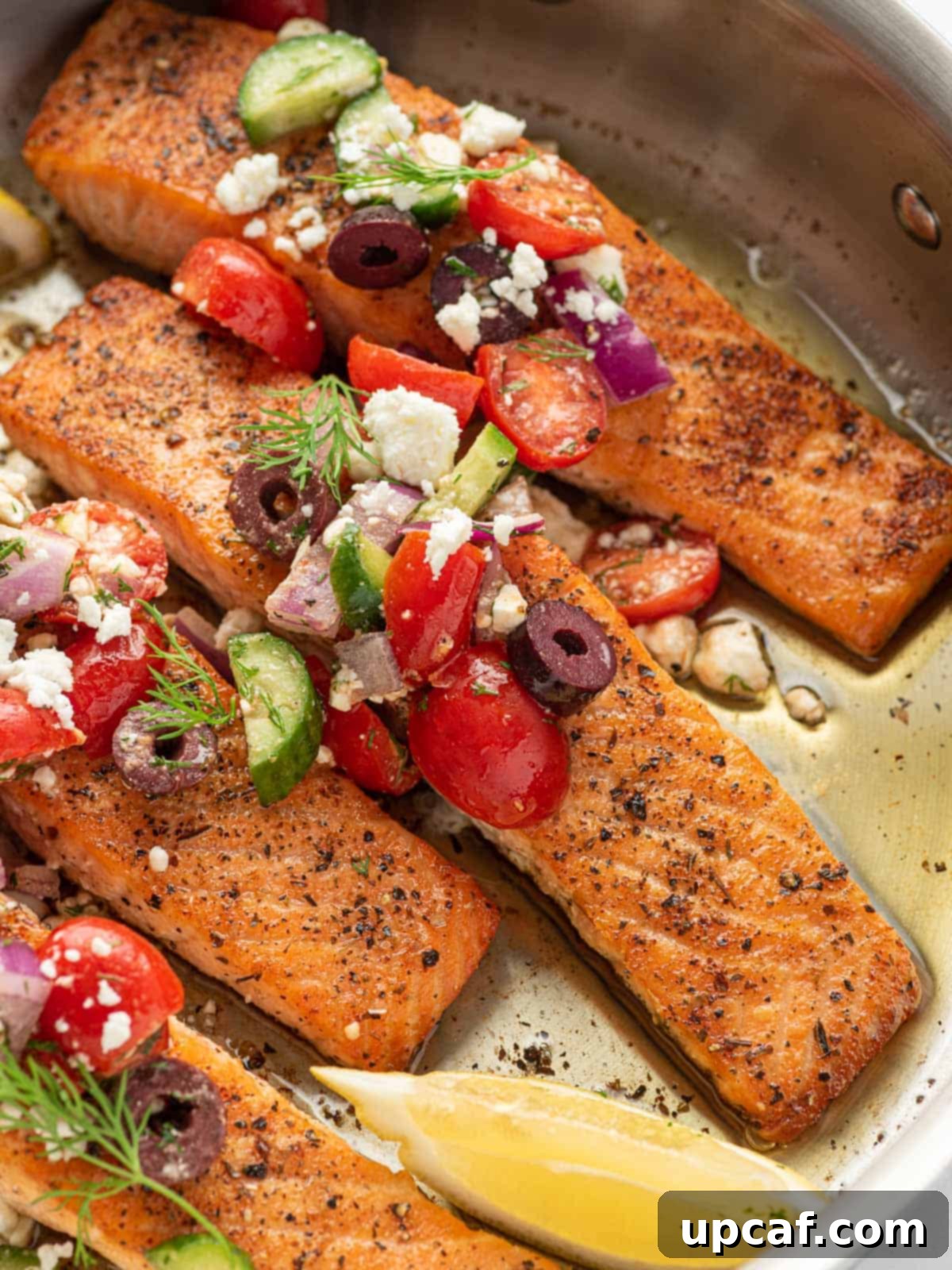
Explore More Easy & Delicious Seafood Recipes
If you loved this Greek Salmon, you’ll be thrilled to discover more of my simple yet sensational seafood creations:
- Air Fryer Salmon: Achieve perfectly crispy and tender salmon with minimal effort using your air fryer.
- Honey Garlic Salmon Bites: Irresistibly glazed, bite-sized salmon pieces perfect as an appetizer or a quick main.
- Air Fryer Mahi Mahi: A quick and healthy way to prepare flaky, flavorful mahi-mahi.
- Simple and Flavorful Grilled Garlic Shrimp: Juicy shrimp marinated in garlic and grilled to perfection – ideal for summer.
- Creamy Tuscan Salmon: Indulge in rich, creamy salmon simmered with sun-dried tomatoes, spinach, and garlic.
This Greek Salmon Recipe is more than just a meal; it’s a celebration of fresh, vibrant flavors and healthy eating. With its effortless preparation, nutritious ingredients, and exquisitely delicious taste, it’s destined to become a cherished favorite in your culinary repertoire. Whether you’re planning a quick family dinner or entertaining guests, this dish promises a complete Mediterranean experience that everyone will adore. Its versatility allows for endless pairing possibilities, ensuring every meal feels fresh and exciting.
If you give this exceptional recipe or any of my other creations a try, I would be absolutely thrilled to hear from you! Please consider leaving a star rating and a comment in the section below to share your experience. Your feedback helps me and other home cooks. Additionally, make sure to follow Cookin’ With Mima on Facebook | Instagram | Pinterest to stay updated with all my latest posts, culinary inspirations, and delicious recipes!

Pin
Greek Salmon
Ingredients
To cook salmon
- 4 8 oz. salmon fillets, skinless or skin on
- 2 tablespoons olive oil, divided
- ½ teaspoon dried oregano
- ½ teaspoon dried basil
- ½ teaspoon garlic powder
- ½ teaspoon onion powder
- ½ teaspoon salt
- ½ teaspoon ground black pepper
To prepare Greek salsa
- ½ cup grape tomatoes, halved
- ⅓ cup cucumber, sliced
- ⅓ cup red onion, diced
- 3 tablespoons kalamata olives, sliced
- 2 tablespoons feta cheese
- 1 tablespoon olive oil
- 1 tablespoon lemon juice
- ½ tablespoon fresh dill leaves, chopped
- Salt & pepper, to taste
Instructions
- Brush a tablespoon of olive oil over the salmon fillets on both sides. Pat dry if needed.
- In a small bowl, mix the seasonings: oregano, basil, garlic powder, onion powder, salt, and pepper. Rub the seasonings over the salmon evenly, ensuring all surfaces are coated.
- Heat a large skillet with the remaining tablespoon of olive oil over medium-high heat until shimmering. Add the salmon fillets (skin-side down first, if applicable) and fry until crispy and golden for 4-5 minutes. Gently flip to the other side and cook for an additional 2-3 minutes, or until the salmon is cooked through and flakes easily.
- Meanwhile, prepare the salsa. In a wide bowl, combine the grape tomatoes, cucumber, red onion, kalamata olives, feta cheese, olive oil, lemon juice, dill, salt, and pepper. Gently toss all ingredients together until well mixed.
- Serve the freshly cooked salmon immediately, topped with a generous spoonful of the vibrant Greek salsa.
Notes
- Serve Immediately: This dish is best enjoyed fresh, so serve it as soon as it’s cooked to experience the optimal temperature and texture contrast.
- Use Fresh Ingredients: Fresh lemon juice, garlic, and herbs make a significant difference in the vibrant flavor of the dish. Prioritize fresh for the best results.
- Don’t Overcook the Salmon: Cook the salmon just until it flakes easily with a fork to keep it moist and tender. Overcooking leads to dry, tough fish.
- Marinate for Extra Flavor: For a deeper flavor profile, allow the salmon to marinate in the lemon-garlic-herb mixture for at least 15 minutes before cooking, or up to 2 hours in the refrigerator.
Nutrition
Like this recipe? Rate and comment below!
